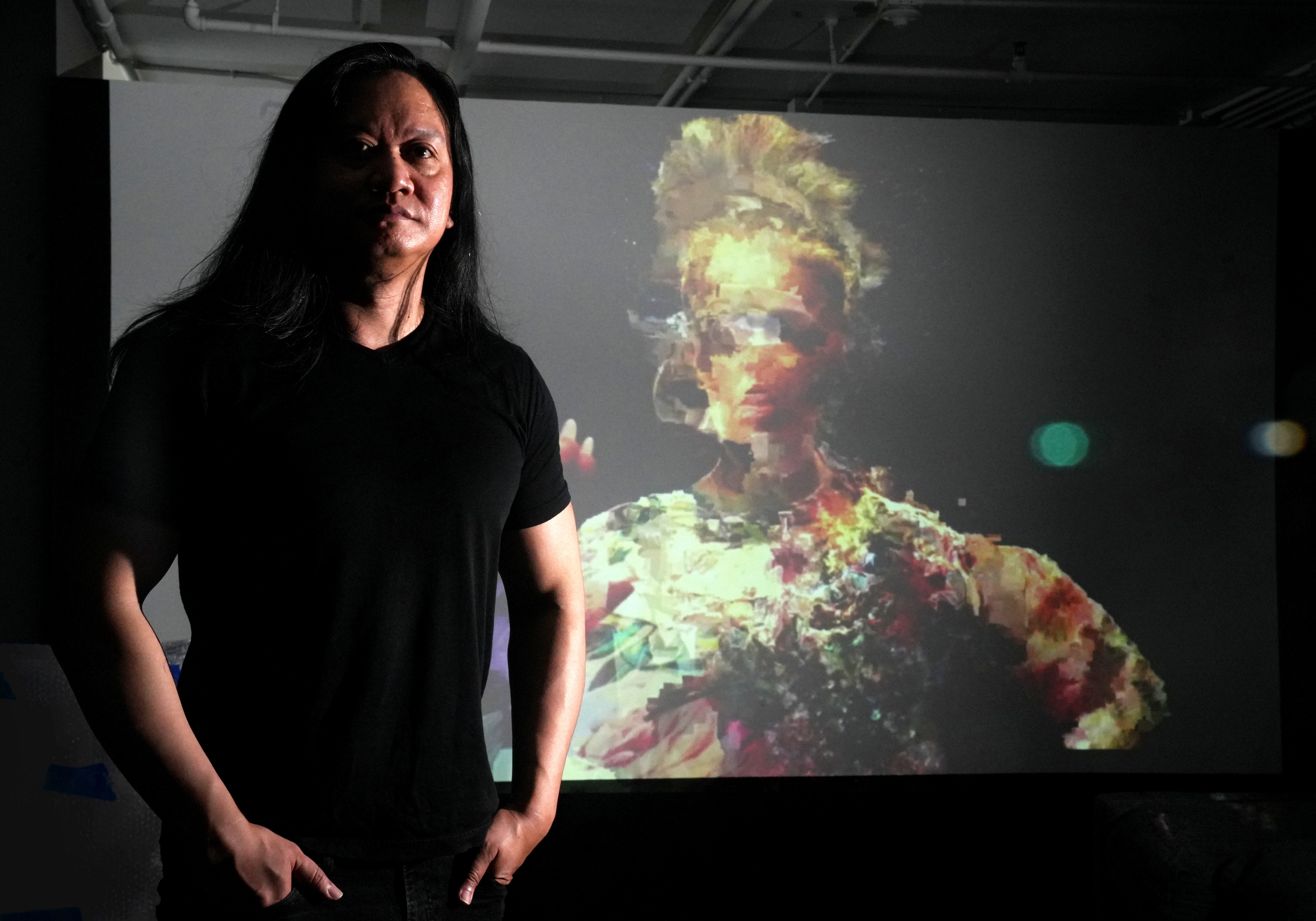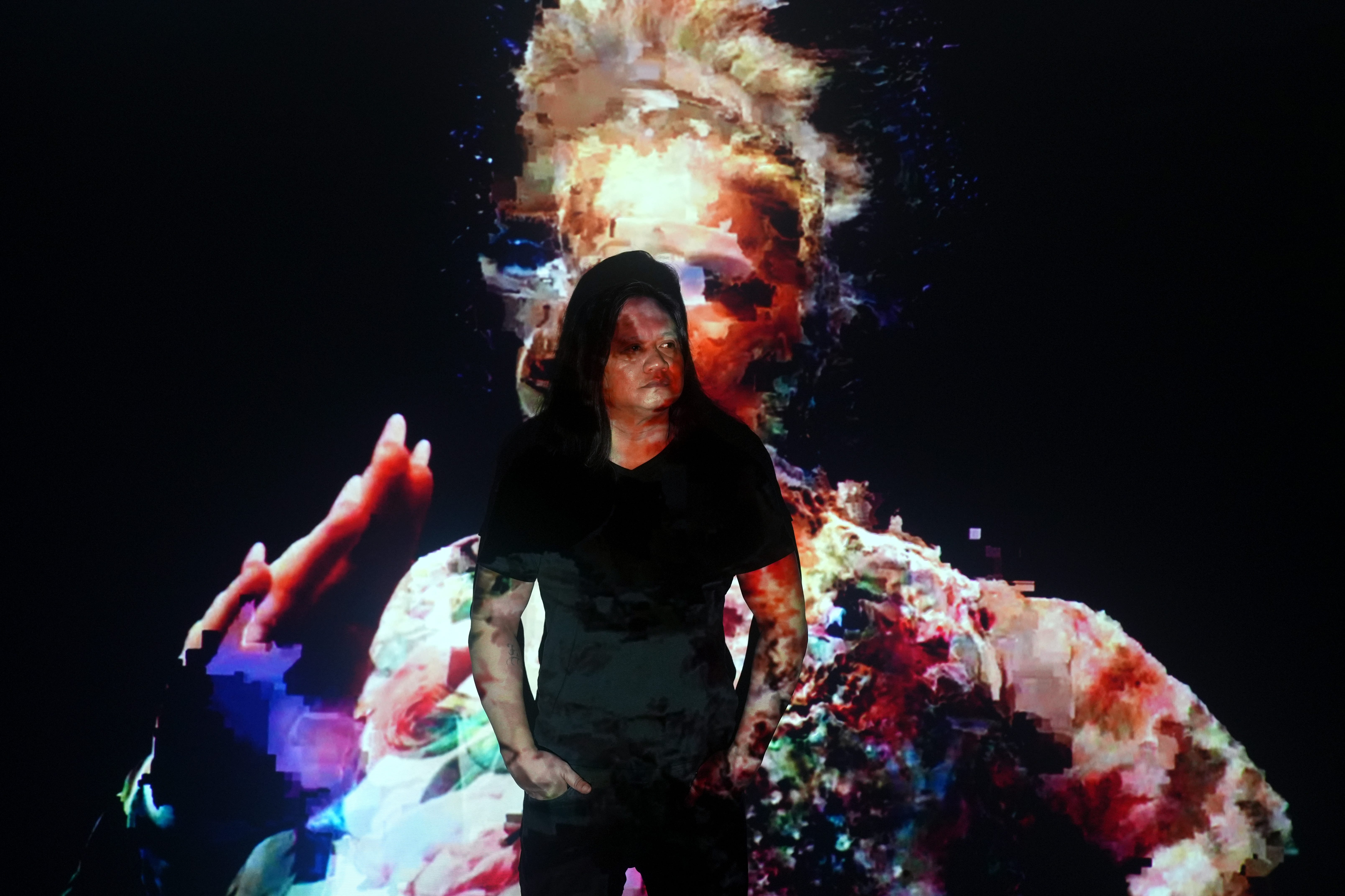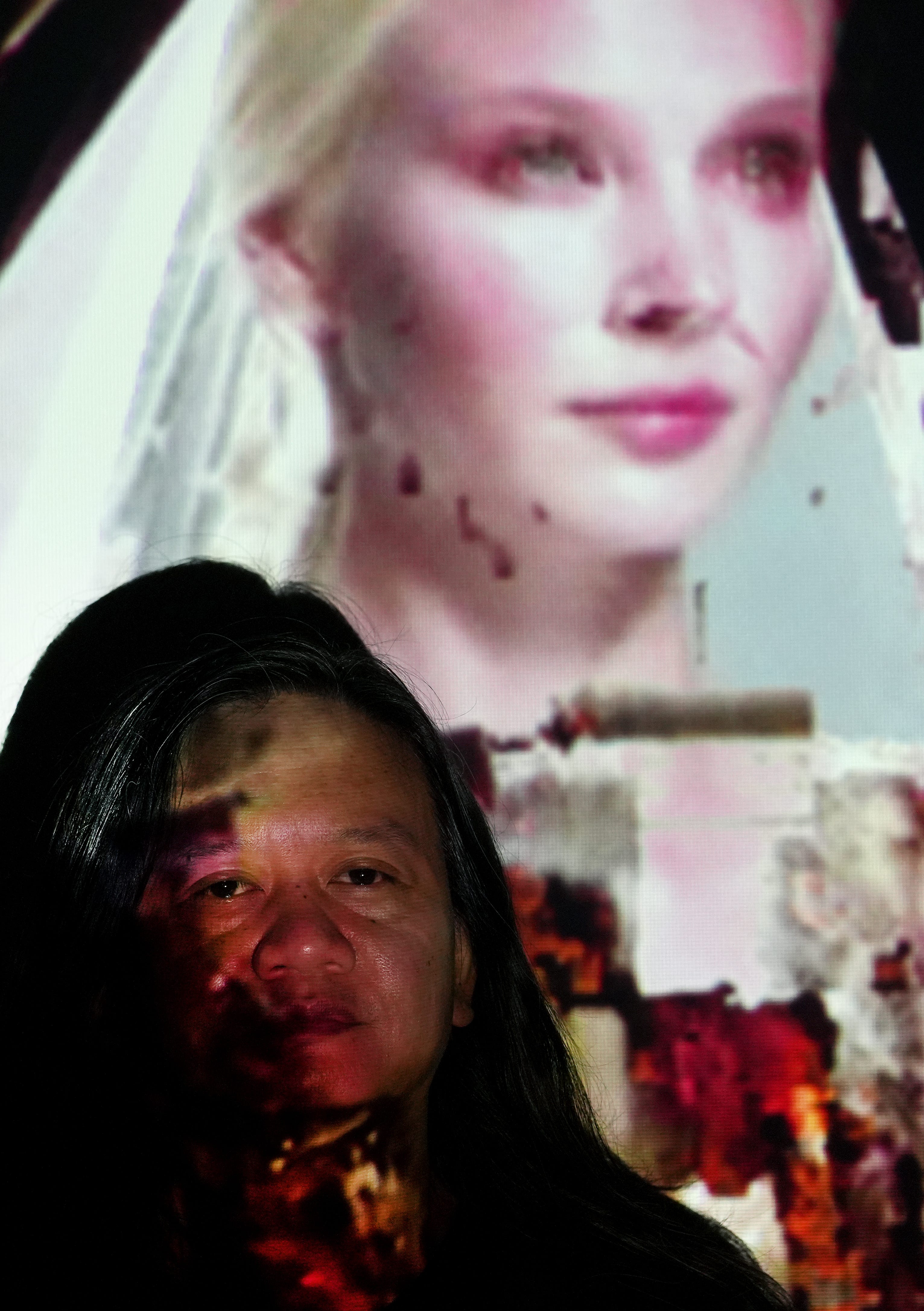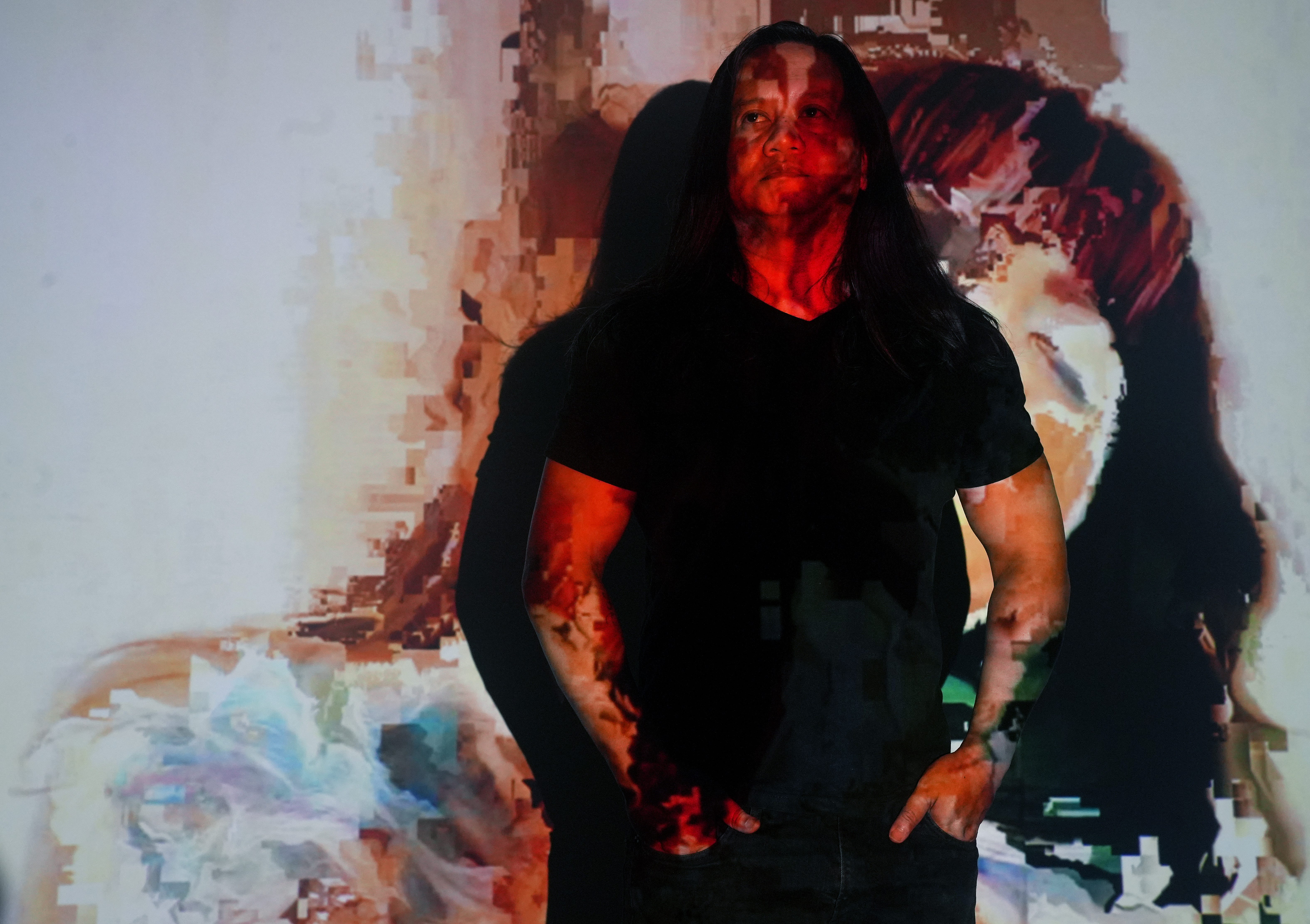
Rembrandt Quiballo gets questions about his name a lot.
Yes, that’s his real first name. As his parents were thinking of baby names, they were also taking an art class. They liked the name of the Dutch master and settled on it for their third child.
And their Rembrandt would also grow up to become an artist. His medium is digital, tuned into the changing technology landscape and inspired by the experiences of his early life in the Philippines and the media he consumed.
He would grapple with questions of religion and culture in his personal life as he moved around the world. Those moves caused him to consider his identity in new contexts and societies, which shaped his artistic voice.
He says he had always felt creatively inclined, expressing himself through music and writing. But he found his passion in visual arts, first in acrylics and oil, and later using photography, digital media, video, augmented or virtual reality programs and NFTs (non-fungible tokens, another type of digital art).
In his work, screen glitches become smudges of paint. Glowing pixels form highlights and shadows. Pop figures like Miley Cyrus and Meghan Trainor are muses for a futuristic take on classical art.
“I love technology, and being on the forefront of it,” he said. “But it doesn't have to be hyperreal. I like it to be painterly at the same time.”
It’s a goal he’s striving for in one of his latest works, an augmented reality piece created in partnership with University of Arizona College of Medicine associate professor Theresa Currier Thomas, who studies traumatic brain injury. The duo is one of several whose work will be on display in a public show of artist-scientist collaborations in September at UA’s Health Sciences Education Building.

In Quiballo’s piece for that show, an iPad reveals cross-sections of brain scans projected into three-dimensional space. Viewers can walk between the panels that exist in the cloud and look up close at an artistic depiction of brain trauma.
Even when he takes on polarizing topics like religion and science, Quiballo hopes to achieve an aesthetic quality that compels people to keep looking.
“My art tries to touch on difficult subject matter,” he said, “and it tries to get people to look at things differently. But (it can) still be beautiful.”
A cosmopolitan upbringing
Quiballo was born in Manila, in the Philippines. His dad was an airplane mechanic and frequently worked outside the country, sending money back to the family.
Then came a period of intense change for the Philippines: Benigno Aquino, Jr., the main political rival of dictator Ferdinand Marcos, was shot and killed at the Manila airport. That sparked a revolution and ultimately led to the downfall of Marcos. Aquino Jr.’s wife, Corazon Aquino, succeeded Marcos to become the first female president of the Philippines.
Quiballo’s father, worried for his family’s safety, wanted them to leave the Philippines. So they traveled with his dad to Saudi Arabia, then Amsterdam and eventually to the United States in pursuit of better education and opportunities.
He was only 8 while they lived abroad, but Quiballo remembers the experience of shifting from culture to culture, and the jarring moments that came with those shifts.
“I was definitely like ‘woke’ at a young age,” said Quiballo, chuckling. “I was thinking about things where, you know, (some) kids probably wouldn't have to think about those things.”

He recalled being raised Mormon in the Philippines, a country that was predominantly Catholic, and then moving to Saudi Arabia, where his family was not allowed to practice their faith openly. They would go to trusted friends’ houses to perform religious rites. His parents would tell him that if anyone found out they were members of the Church of Jesus Christ of Latter-day Saints, the consequences could be grave.
“(I was) too young to understand the world, but (I) got glimpses of it,” he said.
When his family finally settled in Tucson, Quiballo said he adapted to American culture relatively easily. He owes that in part to his early exposure to television, from cable news to reality TV, which helped him absorb a new identity and understand his new country better.
“Being an immigrant definitely affected my work,” he said. “I think that started my fascination with (TV), being an outsider from a different country.”
Becoming an artist
Quiballo’s path to becoming an artist wasn’t easy. Coming out of high school, he had a scholarship to the University of Arizona, but he says he felt unprepared and was unable to keep his GPA high enough. So he lost the scholarship.
He then attended Pima Community College, and there he worked multiple jobs — as a server in restaurants, helping artists with odd jobs — all while trying to keep his grades up.
He also describes that period as a time when he was trying to “find himself,” which added to his practical challenges.
“It was a bit of a struggle,” he said.
Eventually, Quiballo was able to return to UA for his undergrad and ASU for his MFA. During that time, he developed and refined his artistic process.
It all started with the technology of the 1990s. He kept trying to use a film camera to capture stills of TV screens, but the images were distorted. So he experimented with a Polaroid, and blocked off the flash, which softened the light coming off the TV — almost like a painting.

The resulting images catalyzed his ongoing fascination with the rise of the moving image. Quiballo described the texture of 8 millimeter film, the advent of video and VHS, and the quality of digital pixels as sources of inspiration.
“I think the medium that we use affects how we think about things,” he said.
Now, as a professional artist, Quiballo has participated in dozens of solo and group exhibitions, both in and outside of Arizona, and has earned grants and scholarships to fund his work. But he acknowledges that it can be a difficult career to pursue, made more discouraging by the lack of a straightforward path or reliably steady income.
“It’s a slow learning process of how being an artist works,” he said. “A lot of people want to be artists, but to actually make a living out of it, or to be able to thrive, is harder.”
Asking the hard questions
For Quiballo, the challenge of becoming an artist wasn’t just about the money, or honing his technique. It was also about dealing with the conceptual questions that shaped his life as well as his visual creations.
He described how, as a Filipino person, being raised Mormon felt isolating at times.
“Being in that religion,” he said, describing doctrines that looked down on darker-skinned people, “I really felt like an outsider.”
As a teenager, he rebelled against his religious upbringing, a decision the rest of his family didn’t necessarily understand. It’s something he’s come to terms with, he said, but that still influences the way he creates art.
“Religion is a polarizing thing,” he said. “I see mass media as a form of religion. … There's definitely a need for people to want to know how to act, and I think popular culture does that now.”
That, he says, is partly why he uses television and digital media in his craft — because, just like in religion, he wants to use art to find truth. That truth, he says, isn’t static or absolute, but can also be built on the questions and relationships sparked by images.
“My art tries to touch on sometimes difficult subject matter,” he said. “It’s talking about things, bringing forth the issues that are hard to talk about, and sometimes people don’t want to hear it, but through art you can touch on these things … and look deeper into it.”
And in his latest work, visitors can quite literally look deeper into it. They can enter the world he imagines and stare at the brain — cross-sectioned in pixelated form — right before their eyes.
You can see Quiballo's work at the Artist + Researcher Exhibition at the Health Sciences Education Building. For more information, visit the UA College of Medicine website.
Independent coverage of bioscience in Arizona is supported by a grant from the Flinn Foundation.
Melina Walling is a bioscience reporter who covers COVID-19, health, technology, agriculture and the environment. You can contact her via email at mwalling@gannett.com or on Twitter @MelinaWalling.
